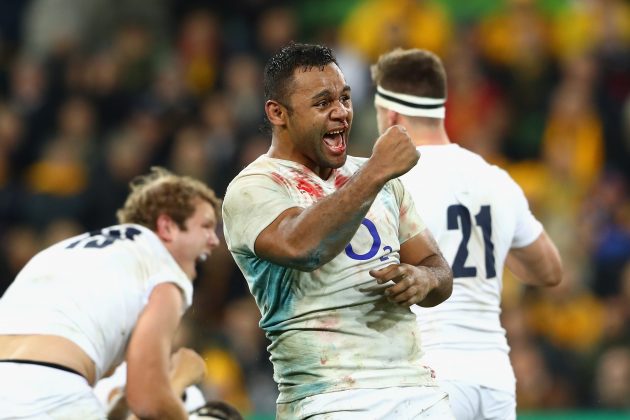With Billy Vunipola's admission that he might try out for the NFL after the 2019 Rugby World Cup, the portents do not look encouraging if you look at previous attempts
Just weeks after Twickenham played host to an historic NFL game, the influence and pull of the gridiron field looks to be exerting itself on the world of rugby.
Speaking to Ben Kay for The Times, current England No 8 and one of the brightest prospects in Eddie Jones’ side, Billy Vunipola, expressed his interest in making the transition to the NFL after the 2019 Rugby World Cup.
Vunipola certainly has a physical skill set which could serve him well but before he makes any bold decisions, there a number of cautionary tales he should harken to.
His former Saracens teammate Hayden Smith tried to make it with the New York Jets in 2012 but returned to rugby after amassing a total of one reception for 16 yards during his time in the sport.
Rugby League has also seen players attempt the transition, with Jarryd Hayne initially sticking with the San Francisco 49ers last year as a punt returner, but found himself cut due to an inability to keep hold of the ball when the big hits came in.

The Hayne Train: Jarryd Hayne had a stint with the San Francisco 49ers
England RL’s own Tom Burgess had trials with the New York Giants, Buffalo Bills and Seattle Seahawks last year but nothing came of it and he is currently representing England in the Four Nations.
The issue is not that Vunipola doesn’t have the physical skills that NFL teams would look for in a potential player, it’s that he would be attempting to learn an entirely new sport, alter his physical conditioning and play said sport at a professional level all at the age of 27.
We have seen with players like Smith, Hayne and Burgess that NFL teams are not willing to commit to developmental projects unless those projects are in their early 20’s, such is the small window of peak physical performance that the NFL operates within.
Even transitioning young is no guarantee of success, with British Olympian and rugby player Lawrence Okoye spending three years with the 49ers, Arizona Cardinals, Jets and Dallas Cowboys, but did not play in a regular season game or make a final 53-man roster over that period.

Learning curve: Former rugby player Lawrence Okoye tried gridiron
Because of his younger age – he was 21 when he first signed up with the 49ers – and undoubted potential, Okoye was able to stick around the league for a few years, playing and developing on teams’ practice squads. It may not have worked out for Okoye – yet – but the decision to move early was the right one and he gave himself the best opportunity possible to make a success of it.
All these examples demonstrate just how difficult of a transition it is to make.
Whilst rugby players are conditioned to play with intensity and power for 80 minutes, NFL players are conditioned to run faster and hit harder, in much smaller and even more intense bursts. Having that dynamic physical ability is rare, even in a game as physically-impressive as rugby.
If you do have those rare physical traits, such as Okoye and Hayne clearly did, it’s then a case of learning entirely new techniques, many of which have no transferable properties from rugby. Blocking, coverages and the initiation of contact without the ball – and the ensuing hand battle – are unlike anything in rugby and these are areas where players, such as Vunipola, would be starting from scratch.

Touchdown: American footballer, Nate Ebner, scores during the Olympics
Assuming a player achieves that, then comes the learning of the War and Peace-sized playbooks and extensive play-calling verbiage. It’s one thing to dominate physically and learn the requisite technique, it’s another to combine that with the ability to mentally scan the entire playbook, line-up in the right position and know your offensive play or defensive assignment all within the space of a split second.
That said, for all the tales of pessimism, there is a very prominent success story in New England Patriot and recent Rugby 7s Olympian, Nate Ebner.
The safety has transitioned between both sports with success and although he didn’t play the sport at high school level, he did play for two years at the collegiate level before being drafted. This, combined with his exposure to the sport as a youngster growing up in the United States and the physical abilities that playing Test rugby had given him, was enough for Ebner to make a success of the move.
The ideal situation for any rugby player hoping to swap rucks and scrums for play action passes and safety blitzes is to go as early as possible and look to play the game at the college level and earn their stripes there. The quality of opposition will still be very high and the learning curve steep, but it’s a far more manageable way of learning the sport than being dropped straight into the pros.

Runaway train: Tom Burgess playing with the Rabbitohs had an NFL trial
The message to Vunipola should be – to the likely dismay of England and Saracens fans – that, if he is serious about making the transition, he should go now, whilst he still has time on his side.
With the UK’s ever-increasing interest in the NFL – and vice versa – and the lure of a payday that rugby can’t even begin to match, Vunipola won’t be the last player to give this move some thought.
The odds are stacked against him, but at least as an established player, he has the safety net that he can fall back into a rugby career should the move prove unsuccessful and he doesn’t have too much to lose by exploring the option.





